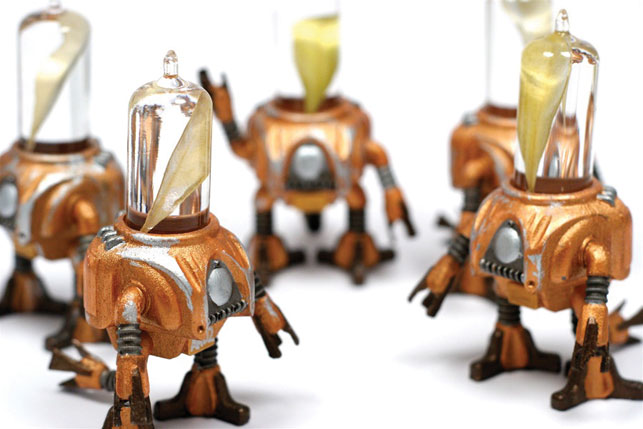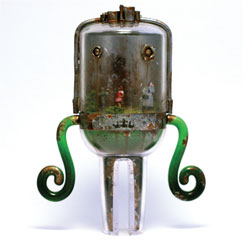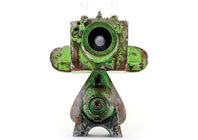The urban art scene has seen a commercial boost into the mainstream of late; a niche collectors market for figures is now a million dollar industry the world over.
Around the world artists are making models with a twist. Robots stalk, Manga animals threaten, and aliens pose – all in great detail, standing a few inches tall. These creations are hugely desirable to collectors who pay big bucks to get hold of the latest limited edition or custom pieces by their favourite designers.

The rough surface finish of stereoligthography helps give this rusty ‘Rotund’ plenty of character
The models are an extension of what is better known as the ‘urban vinyl’ or ‘designer toy’ scene, the biggest names being Dunnys (by Kidrobot) and Qees (by Toy2r). The industry’s high turnover rate means that artists rush to get their latest creation out to the masses, something that commonly proves a costly and time consuming process.
Production values

Traditionally there have been two types of models – vinyl and resin. Vinyl is best suited to large batch production as Cris Rose, a prominent London based urban vinyl artist, explains. “Mould making for vinyl can cost thousands, partly because it requires expensive rotational casting machines.” However, once the mould is made models are cheap to produce with a 2,000 piece run producing a wholesale cost of £30.
Large batch production in vinyl is not always practical, and to preserve exclusivity for an artist, limited edition runs might be preferred. These are made out of resin and the moulds for this process are much cheaper to produce because they are gravity fed and don’t require machinery. For short batches though they are still not particularly cost-effective as each original needs to be made by hand using modelling foams, polymer clays, found objects and car bodyfiller.
Mass customisation
With a view to driving down the cost of short batch production runs, Cris looked at rapid prototyping and found detailed originals could be produced for £100 or less. “These are the kind of originals that you would have had to have gone to a professional model maker for and spent over £750 on – up to £3,000 on a larger, very complicated design that has a lot of revisions.

“Using RP means you can get a very high quality original to cast from, but as we don’t need to sell a lot of pieces to break even, we can take more risks and produce lower numbers. Lower numbers means more exclusive and often more desirable,” adds Cris.
Starting with initial sketches, Cris then develops them inside SolidWorks to create a 3D model. This is sent to a rapid prototyping bureau and the returned figure is hand finished, before the silicone mould is created. The resin is then poured in and once set, it is cleaned, assembled and painted.
Rapid prototyping has done more for Cris than just reduce costs. He can now make much more detailed models than were previously possible with resin.
“With these designs I’ve purposely made them as thin as I could to see what I could get away with,” says Cris showing off a model’s robotic arms done in stereolithography. “You can print these tiny, little details with this type of rapid prototyping, but you can’t really cast it in resin particularly well because you get air bubbles trapped and you end up with an arm in two pieces.”

Rapid Prototyping has helped Cris Rose create a collection of Urban Vinyl individuals
In cases where manufacturing issues dictate the form of the model, Cris needs to make adjustments to the design and this is where CAD is incredibly useful. “One reason why I use SolidWorks rather than other programs is because I can almost go all the way back to the first bit of size and shape detail I put into it and just change the sizes.”
“There is no [other] way I’d be able to create something so detailed, so dimensionally perfect and have it put into production in such a ridiculously short timescale.”
Cris has always been computer literate, using CAD of his own accord back in his school days when systems were in short supply in education. Now it means he can work quicker, cheaper and give his models individual personality.
“In a lot of ways it allows me to produce new iterations, new versions and more diversity in the characters I was doing without having to do a whole new sculpture, new moulds and everything else.
“If you design it like a real product, such that they’d actually have separate joints and pieces, then you’re able to make a few different types of arms that fit the same body. They’re ever so slightly different, but it’s enough to change the whole character and expression. Whereas when working with resin where the whole character is just a single piece, arms moulded into the body, if the artist wanted to do anything further with it then it would have to be a completely new sculpture.”

The rapid prototyped figure has a rougher surface than most modellers would appreciate but for Cris this is beneficial. “I’m trying to do something which in the end looks like this when it’s painted up,” he says pointing to a finished Rotund, one of his most popular designs, “Old and rusted with lots of character – a super-smooth finish would have been counter productive.”
His influences are nature and technology: “I like the old with the new, the futuristic designed in the 1950s. [A time when] they thought we’d have little guys like this running around the house.
“A lot of modern design tends to be take away all the buttons, take away all the character – smooth it off and make it flat and perfect. Don’t get me wrong, I’m a huge Apple fan, I love the simplicity, but it seems to me that if you were going to have a robotic companion you’d want it to have personality.”
The collectables are usually produced in runs of around five pieces, although a cast from an RP model can last for up to 40 resin copies.
The future
The next step for Cris is to get his designs out to the masses. “I’m currently doing some designs for vinyl production, but the initial costs are over 50 times higher and the project has required a manufacturing partner in Japan,” he says. Whichever path he chooses, mass production or bespoke creations, Cris dreams of having his own rapid prototyping machine. This will give him instant control over modelling changes, and a whole new army of individuals to unleash on the urban vinyl art world.

How rapid prototyping has transformed a global sub-culture with a huge following






